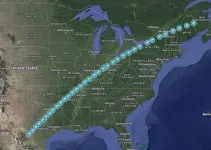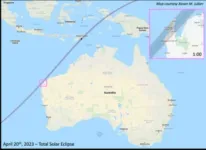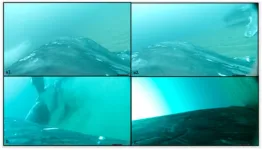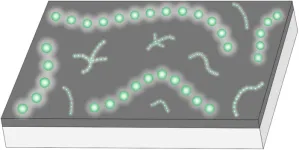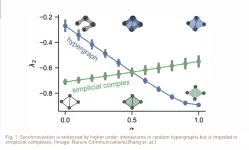(Press-News.org) SAN ANTONIO – 4.20.23 -Scientists from Southwest Research Institute (SwRI) led a team in the unique Citizen Continental-America Telescopic Eclipse (CATE) experiment to image the Sun’s outer atmosphere, the corona, during a short solar eclipse on the opposite side of the Earth. Using four platforms in the northwest corner of Australia, the team successfully observed the million-degree solar corona at the April 20 eclipse viewed from the Exmouth peninsula. The Australian eclipse serves both as a unique scientific opportunity and a training exercise for the program’s leadership in preparation for the 2024 U.S. eclipse.
The CATE 2024 team traveled nearly 10,000 miles for one minute of totality to observe the Sun’s corona from the unique perspective offered by total solar eclipses. These phenomena allow scientists to view the complex and dynamic outer atmosphere in ways that aren’t possible or practical by any other means, opening new windows into our understanding of the solar corona. SwRI is leading the Citizen CATE 2024 experiment, a broad scientific outreach initiative that will make a continuous 60-minute high-resolution movie during the April 8, 2024, solar eclipse over the United States. CATE 2024 will use a network of 35 teams of citizen scientists representing the local communities within the eclipse shadow path.
“Even though this was a very short eclipse, our team of community scientists performed flawlessly and captured fabulous images of the structure of the elusive solar corona,” said Dr. Amir Caspi, a principal scientist at SwRI in Boulder, Colorado, and leader of the CATE 2024 project.
The observations obtained by the team will allow scientists to study the complexities of the Sun’s corona including its complicated shape, how it changes over time, or what causes the corona to reach temperatures of millions of degrees Fahrenheit. Today’s images from Australia will also help the team to refine its experimental procedures for the immense, distributed community effort in the United States next year.
“This eclipse provided the perfect opportunity to test our equipment and procedures, and to train our community leaders for the next eclipse in 2024,” Caspi said. “When it comes to preparations for this kind of major effort, there’s no substitute for the real thing.”
The Citizen CATE 2024 project is funded by grants from the National Science Foundation and NASA, is led by SwRI, and includes the National Center for Atmospheric Research, the National Solar Observatory, the Laboratory for Atmospheric and Space Physics at the University of Colorado Boulder, and the Space Science Institute. Beyond its scientific goals, the project aims to engage many unique and diverse communities along the eclipse path as an integral part of a major scientific research effort.
“Total solar eclipses provide wonderful opportunities to bring together the public and science,” said Dr. Carrie Black, program officer for the National Solar Observatory at the NSF Astronomical Sciences Division. “The Citizen CATE 2024 project leverages the public value of science to create a lasting educational impact for both the scientific and local communities.”
“Citizen CATE is part of a growing family of NASA citizen science projects gearing up for the Heliophysics Big Year initiative in 2023-2024, inspiring joy and curiosity along with excellent participatory science opportunities,” said Dr. Elizabeth MacDonald, Citizen Science Strategic Working Group lead at NASA.
The current project builds on the experience of the first Citizen CATE experiment, which used 68 stations to observe the August 2017 total solar eclipse that crossed the entire continental United States. CATE 2024 expands the scientific objectives by measuring polarized light and engages with teams across the new eclipse path. Dr. Sarah Kovac, a 2017 CATE participant and now a postdoctoral researcher at SwRI, serves as project manager for CATE 2024.
“Participating in CATE as a young undergraduate inspired me to pursue a career in heliophysics,” said Kovac. “Seven years and one Ph.D. later, I get to be on the professional side of planning an eclipse expedition, and it’s beyond exciting to share this passion with the next generation of young scientists.”
The 2023 Australian observation effort includes team members from SwRI, NSO, NCAR, the University of Northern Colorado, Rice University, the University of Indiana, and the University of Maine.
The project will begin to recruit teams from eclipse path communities in Fall of 2023. Interested parties can find more information and a contact form on the project’s website, https://eclipse.boulder.swri.edu.
For more information, visit https://www.swri.org/heliophysics.
END
SwRI-led team successfully observes Australian eclipse in preparation for 2024 US eclipse
Pathfinding exercise paves the way for extensive US observations in 2024
2023-04-21
ELSE PRESS RELEASES FROM THIS DATE:
When an earthquake strikes, how do Mexico city hospitals respond?
2023-04-21
Staff in public and private hospitals in Mexico City are likely to follow well-established and reinforced earthquake early warning (EEW) protocols for evacuation, according to an ongoing study.
Overall, staff are likely to follow the protocols especially when they are “reinforced with drills that help practice the correct protective action,” said Sandra Vaiciulyte of Universidad Nacional Autónoma de México. She discussed her research at the Seismological Society of America (SSA)’s 2023 Annual Meeting.
In the study, there have been “no accounts of injuries of patients and staff because of the particular reaction by staff,” ...
The mental health of pediatric ICU teams: how has the pandemic affected these professionals?
2023-04-21
Concern about the mental health of hospital professionals has been increasing in recent years, and when, in early 2020, the Covid-19 pandemic was declared and rapidly spread, there was a large increase in the overload of workers in Intensive Care Units (ICUs). Given this, researchers from the D’Or Institute for Research and Education (IDOR) and other national institutions assessed the prevalence and extent of psychological disorders such as burnout, anxiety, depression, and post-traumatic stress disorder ...
Ridgecrest faults increasingly sensitive to solid Earth tides before earthquakes
2023-04-21
Faults in the Ridgecrest, California area were very sensitive to solid earth tidal stresses in the year and a half before the July 2019 Ridgecrest earthquake sequence, researchers reported at the Seismological Society of America (SSA)’s 2023 Annual Meeting.
“The signal of tidal modulation becomes extremely strong” after 2018, said Eric Beauce of Lamont-Doherty Earth Observatory, who noted that the signal was identified with seismicity that occurred around the faults that broke in the 2019 magnitude 7.1 earthquake.
The link ...
New study reveals that childhood adversity is linked to an increased risk of developing type 2 diabetes as young adults
2023-04-21
A new study published in Diabetologia (the journal of the European Association for the Study of Diabetes [EASD])finds that individuals who experienced childhood adversity are at increased risk of developing type 2 diabetes (T2D) in early adulthood.
The research was conducted by Assistant Professor Leonie K. Elsenburg and colleagues at the Section of Epidemiology, Department of Public Health, University of Copenhagen, Copenhagen, Denmark and aimed to determine whether there was a link between childhood adversity and the development ...
Reducing fatigue and errors among nurses working night shifts
2023-04-21
Nurses exposed to 40 minutes of bright light before their night shifts feel less fatigued and make fewer errors at work, according to a study led by McGill University. The nurses also slept better after their shifts.
“Healthcare workers are experiencing high levels of fatigue due to staffing shortages, difficult schedules, and heavy workloads. Further, the cost of medical errors has been estimated at tens of billions of dollars per year in North America,” says Jay Olson, the senior author of the recent study in Sleep Health, ...
Surgery most effective treatment of metabolic liver disease
2023-04-21
Metabolic (bariatric) surgery is more effective than medications and lifestyle interventions for the treatment of advanced non-alcoholic fatty liver disease.
A new paper, published today in The Lancet by King’s College London and the Catholic University of Rome, is the first to compare three active treatments of non-alcoholic Steatohepatitis (NASH) and to specifically investigate the effectiveness of metabolic surgery (weight loss surgery) in a randomised clinical trial.
Non-Alcoholic Fatty Liver Disease (NAFLD) is the most common cause of chronic liver disease, globally affecting 55% of people with type 2 diabetes and 75% of those with obesity. Non-alcoholic ...
Whales stop by Gold Coast bay for day spa fix with full body scrubs
2023-04-21
A new Griffith University study has found that humpback whales will use sandy, shallow bay areas to ‘roll’ around in sandy substrates to remove dead skin cells on their return journeys south to cooler waters.
Marine ecologist Dr Olaf Meynecke, from the Griffith-led Whales and Climate Research Program and Coastal and Marine Research Centre, used suction cup tags to track southward migrating whales between August 2021 and October 2022.
The CATS tags are fitted with integrated high-definition video, magnesium release system, a VHF transmitter for retrieval, magnetometers, ...
Horodyskia is among the oldest multicellular macroorganisms: Study
2023-04-21
Horodyskia, characterized by a string of beads with uniform size and spacing, is a kind of macroscopic fossil with a record extending from the early Mesoproterozoic Era (~1.48 Ga) to the terminal Ediacaran Period (~550 Ma).
Now, researchers led by Dr. LI Guangjin and Prof. PANG Ke from the Nanjing Institute of Geology and Palaeontology of the Chinese Academy of Sciences (NIGPAS) and Prof. CHEN Lei from Shandong University of Science and Technology have revealed that Horodyskia is among the oldest multicellular macroorganisms and may have attained its macroscopic ...
Study: Do higher-order interactions promote synchronization?
2023-04-20
APRIL 20, 2023
Researchers use networks to model the dynamics of coupled systems ranging from food webs to neurological processes. Those models originally focused on pairwise interactions, or behaviors that emerge from interactions between two entities. But in the last few years, network theorists have been asking, what about phenomena that involve three or more? In medicine, antibiotic combinations may fight a bacterial infection differently than they would on their own. In ecology, survival strategies may arise from ...
Synthetic biology meets fashion in engineered silk
2023-04-20
Scientists have long been intrigued by the remarkable properties of spider silk, which is stronger than steel yet incredibly lightweight and flexible. Now, Fuzhong Zhang, a professor of energy, environmental and chemical engineering at the McKelvey School of Engineering at Washington University in St. Louis, has made a significant breakthrough in the fabrication of synthetic spider silk, paving the way for a new era of sustainable clothing production.
Since engineering recombinant spider silk in 2018 using bacteria, Zhang has been working to increase the yield of silk threads produced from microbes while maintaining its desirable properties of enhanced ...
LAST 30 PRESS RELEASES:
Injectable breast ‘implant’ offers alternative to traditional surgeries
Neuroscientists devise formulas to measure multilingualism
New prostate cancer trial seeks to reduce toxicity without sacrificing efficacy
Geometry shapes life
A CRISPR screen reveals many previously unrecognized genes required for brain development and a new neurodevelopmental disorder
Hot flush treatment has anti-breast cancer activity, study finds
Securing AI systems against growing cybersecurity threats
Longest observation of an active solar region
Why nail-biting, procrastination and other self-sabotaging behaviors are rooted in survival instincts
Regional variations in mechanical properties of porcine leptomeninges
Artificial empathy in therapy and healthcare: advancements in interpersonal interaction technologies
Why some brains switch gears more efficiently than others
UVA’s Jundong Li wins ICDM’S 2025 Tao Li Award for data mining, machine learning
UVA’s low-power, high-performance computer power player Mircea Stan earns National Academy of Inventors fellowship
Not playing by the rules: USU researcher explores filamentous algae dynamics in rivers
Do our body clocks influence our risk of dementia?
Anthropologists offer new evidence of bipedalism in long-debated fossil discovery
Safer receipt paper from wood
Dosage-sensitive genes suggest no whole-genome duplications in ancestral angiosperm
First ancient human herpesvirus genomes document their deep history with humans
Why Some Bacteria Survive Antibiotics and How to Stop Them - New study reveals that bacteria can survive antibiotic treatment through two fundamentally different “shutdown modes”
UCLA study links scar healing to dangerous placenta condition
CHANGE-seq-BE finds off-target changes in the genome from base editors
The Journal of Nuclear Medicine Ahead-of-Print Tip Sheet: January 2, 2026
Delayed or absent first dose of measles, mumps, and rubella vaccination
Trends in US preterm birth rates by household income and race and ethnicity
Study identifies potential biomarker linked to progression and brain inflammation in multiple sclerosis
Many mothers in Norway do not show up for postnatal check-ups
Researchers want to find out why quick clay is so unstable
Superradiant spins show teamwork at the quantum scale
[Press-News.org] SwRI-led team successfully observes Australian eclipse in preparation for 2024 US eclipsePathfinding exercise paves the way for extensive US observations in 2024
